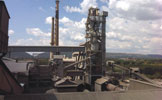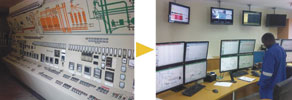

Faced with a growing market demand for cement, together with obsolete supervisory and control equipment, PPC decided to replace the 30-year-old electrical and control systems at its Pretoria-based Hercules facility with sophisticated technology – a major upgrade.
This was done through Wonderware, which in 2010 was ranked number one supplier in the business by Frost & Sullivan. Wonderware’s System Platform, InTouch (HMI), Historian and ActiveFactory (trending, analysis and reporting) suite of solutions was the system of choice.
Introduction
As the leading supplier of cement in Africa’s largest economy, it was imperative that PPC continuously improved efficiencies at its operations to ensure that it supplied the market reliably and consistently. To maintain its leading edge, the Hercules plant went through a major overhaul. In spite of the extensive nature of this upgrade, it was critical that there was as little interruption as possible to the plant’s operations.
The proposal included upgrading the electrical and control systems of kiln 5 and raw mill 3. It covered the replacement of all motor control centre panels (MCCs) and control panels (RIO) to improve the standard of the MCCs, scada and PLC.
In short, this meant replacing a 30-year-old control centre with a new, state-of-the-art solution that was flexible and offered the best in real-time information management and optimised process control.
Project background
The pre-engineering phase involved the gathering of plant information to ascertain exact equipment installed, the determination of process flow diagrams and the updating and redesign of electrical drawings. This enabled PPC engineers to compile a list of equipment to be replaced and to draw up a detailed enquiry document and functional design specification. The purpose of this exercise was to minimise any unforeseen obstacles in the tendering process and to enable potential suppliers to offer an accurate quote. A comprehensive tender document was then drawn up and given to sup-pliers for their consideration.
PPC chose system integrator Quad Automation for the project. “This was a multifaceted and large project,” said Ernie Koopmans, Director, Quad Automation. “All MCCs had to be replaced with modern switchgear as well as the PLC and scada system. There was a limited version of ArchestrA already in place and this had to be expanded and upgraded to the latest version.”
Challenges of the old system
Given the scale of the overhaul, a fine balance was needed between maintaining operations, mitigating potential interruptions and installing new equipment. Some of the challenges management had encountered with the previous, outdated system were:
* Maintenance issues and obsolete equipment – most of the electrical switchgear and instrumentation in use was obsolete compared with the current technology. This older equipment was maintenance intensive and caused prolonged downtime during failures, as most of the original spares were no longer available and modifications needed to be done.
* Limited expansion – existing panels had no more room for expansion or additions, hence retrofitting new equipment incurred a high level of risk. In addition, where loose-standing equipment had been introduced, irregular plant supply was used, cluttering the walls of the substations and jeopardising the equipment installed. Any further expansion, such as the burning of secondary material, would not allow newer equipment to be fully integrated with older equipment. This would force the new expansion to run on semi-automatic with limited control.
* Inflexibility (relay control) – changes were difficult to implement and required extensive rewiring.
* Limited information – there was insufficient information on bin and silo levels and all damper actuators used were discontinued due to their age and shortages of spares. In addition, events were not logged, which meant that cause and effect scenarios could not be determined. Gathering of process information was a lengthy procedure that ended up being useless or inaccurate. This made it difficult to backtrack or get enough information to implement process changes successfully. Gathering information such as alarm and trip settings for auditors was a challenge because there was no central storage repository for all the information.
* Safety issues (compliancy) – the status of the power distribution in the plant was unknown in many cases while some field instruments and relays were filled with liquid mercury, which is hazardous to the environment and to the health of workers.
* Nuisance trips – some temperature devices were hardwired together in order to give temperature differences. When one of the devices failed it had an influence on one or more devices, causing inaccurate readings and unnecessary trips. Also, there were process lines and equipment that had been decommissioned but not taken out of the circuit. Some of these interlocks were still working, resulting in the risk of unnecessary stops and trips.
* Limited data acquisition capability – much of the data was read off chart recorders (provided they had not run out of ink).
Project goals and requirements
To address these challenges, the project had to be ambitious and radical and have the least possible impact on production at the Hercules plant. This entailed the following:
* Establishing a centralised control room – there would be no more isolated sources of data.
* Ensuring the effective measurement of KPIs, logging and trending – for example, cement production is a significant contributor to global fossil carbon emissions. In 1892, PPC situated the plant as far from Pretoria as possible. Today, PPC Hercules has been swallowed up by the greater Pretoria metropolitan complex, making dust management that much more critical.
* Installing a distributed PLC network based on Profibus and remote I/O capabilities.
* Translating the old system into PLC/scada control – although this sounds obvious, the implementation is not. “It was not just the hardware,” said Koopmans. “Perhaps the greatest challenge was migrating operators who for decades have known exactly which button to push under given circumstances to an environment that takes all that away but still needs their understanding of the process.”
* Adding a new Historian server – some standards had already been established with the existing but under-utilised ArchestrA-based system.
* Upgrading all Wonderware licences.
* Replacing all redundant electrical equipment.
* Installing new instrumentation. All this had to happen during the five weeks of the FIFA World Cup, starting in July 2010.
Implementation
It was planned that approximately 60% of the work would begin in January 2010, inclusive of MCC manufacture, new cabling and cable racking. MCC and I/O panels were manufactured off-site with FAT testing being overseen by PPC to ensure that the equipment would be ready for commissioning on delivery. As far as possible, new instruments were also installed, but only powered up on commissioning.
Disconnection of old MCCs took place during the planned Girth Gear replacement in July 2010. Installation of new MCCs, remote I/O panels and connection of new cabling took place during this shutdown.
The ArchestrA Galaxy status showed that 101 templates were used for 3364 instances (objects – motors, dampers, valves, analogues, etc). “The idea was to minimise template design while maximising instance design to make it a manageable environment,” said Koopmans. “Also, standardising displays and icons contributed towards a greater level of operator acceptance and buy-in. This included simulating the analogue displays of the old system which they were used to, as well as filtering alarms so that they were meaningful and prioritised.”

Benefits
The upgrade project resulted in a number of benefits:
* PPC objectives were achieved within time and budget constraints.
* The seamless upgrade to the latest release of ArchestrA made the best possible use of PPC’s existing investment.
* Operator buy-in, early ownership and easier change management were achieved because the system could easily and cost effectively be changed to the user’s liking.
* The working library and structured standards based on best practices saved PPC from expensive experimentation in future upgrades.
* The four-screen design and navigation standard saved operators from having to run around the plant as they could see everything at a glance and navigate to the necessary information easily.
Conclusion
Replacing ageing control systems with modern technology is a complicated process because it means reinventing and reinstalling the control structure of processes that keep the company ticking. This means interfering with the company’s core business operations. When manufacturing companies undertake major upgrades and improvements, the process must be planned well in advance before engineering even begins. However, with today’s technology and system integrator knowhow, it is easier for companies to upgrade than in the past. The alternative is – well, there really is not one.
For more information contact Jaco Markwat, Invensys Wonderware, +27 (0)11 607 8100, [email protected], www.wonderware.co.za
| Tel: | +27 11 548 9960 |
| Email: | [email protected] |
| www: | www.profiafrica.co.za |
| Articles: | More information and articles about PI SA (PROFIBUS & PROFINET SA) |

© Technews Publishing (Pty) Ltd | All Rights Reserved